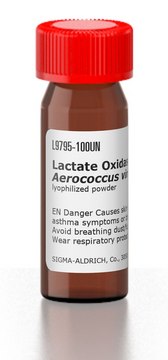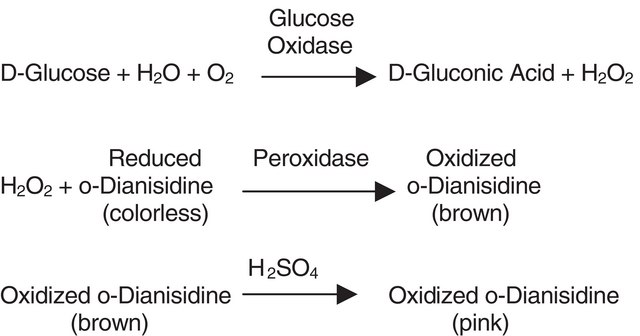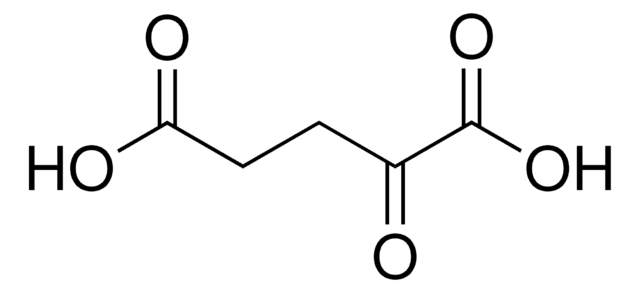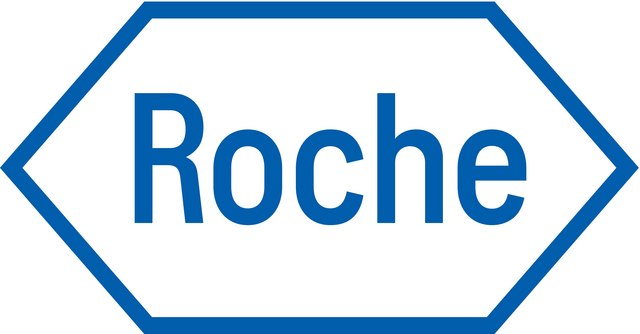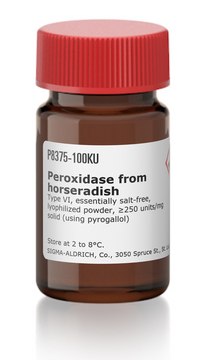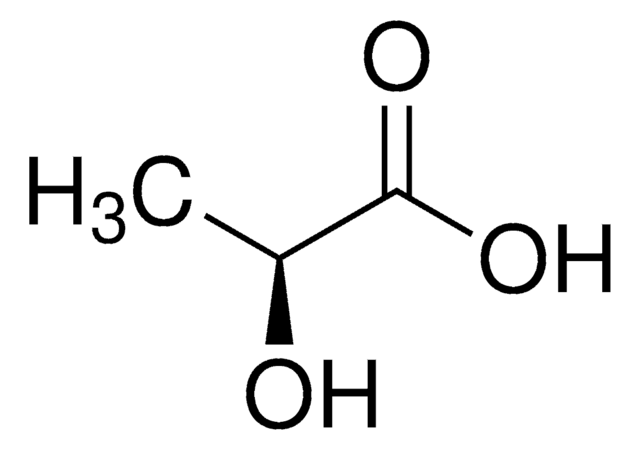L0638
Lactate Oxidase from Pediococcus sp.
lyophilized powder, ≥20 units/mg solid
Sign Into View Organizational & Contract Pricing
All Photos(1)
About This Item
Recommended Products
form
lyophilized powder
specific activity
≥20 units/mg solid
storage temp.
−20°C
Looking for similar products? Visit Product Comparison Guide
General description
Formerly E.C. number 1.1.3.2
Lactate oxidase is a globular flavoprotein and utilizes flavin mononucleotide (FMN) as the cofactor. The enzyme contains a major tyrosine in the substrate-binding pocket and a flavin adenine dinucleotide (FAD) active site. Lactate oxidase has several bacterial sources.
Application
Lactate Oxidase from Pediococcus sp. has been:
- used to functionalize the detection reservoirs for lactate analysis
- used in sequential enzymatic reactions to measure lactate production in the supernatants of microglial cultures
- immobilized onto a carbon electrode to generate a self-powered lactate sensor
Biochem/physiol Actions
Lactate oxidase is used in immobilization or enzyme-based labels for designing biochemical analytical devices such as immunosensors. This enzyme catalyzes the oxidation of lactate to produce pyruvate and H2O2. Lactate oxidase is useful in the first-generation biosensor approach for the electrochemical detection of lactate.
Unit Definition
One unit will oxidize 1.0 μmole of L-lactate to pyruvate and H2O2 per min at pH 6.5 at 37 °C.
Signal Word
Danger
Hazard Statements
Precautionary Statements
Hazard Classifications
Resp. Sens. 1
Storage Class Code
13 - Non Combustible Solids
WGK
WGK 3
Flash Point(F)
Not applicable
Flash Point(C)
Not applicable
Personal Protective Equipment
dust mask type N95 (US), Eyeshields, Gloves
Regulatory Information
新产品
Choose from one of the most recent versions:
Already Own This Product?
Find documentation for the products that you have recently purchased in the Document Library.
Xiang Shen et al.
Organic letters, 14(7), 1744-1747 (2012-03-27)
By making use of the aggregation-induced emission feature of silole 1 and the cascade reactions among l-lactic acid (LA), lactate oxidase (LOD), and dodecanoic hydrazine (DH), a new fluorometric "turn-on" method is developed for the detection of LA.
Parvin Samadi Pakchin et al.
Biosensors & bioelectronics, 122, 68-74 (2018-09-23)
In this work, a novel simple and sensitive electrochemical immunosensor was developed based on lactate oxidase as a single electrochemical probe for the detection of carcinoma antigen 125 (CA125). Chitosan-gold nanoparticle/multiwall carbon nanotube/graphene oxide (CS-AuNP/MWCNT/GO) was used as the electrode
Marcelo Ricardo Romero et al.
Analytical chemistry, 82(13), 5568-5572 (2010-06-04)
An amperometric sensor for lactate quantification is presented. The developed biosensor requires only 0.2 U of lactate oxidase, which is immobilized in a mucin/albumin hydrogel matrix. By protecting the platinum surface with a Nafion membrane, typical interference related to negatively
Jacob M Goran et al.
Analytical chemistry, 83(21), 8123-8129 (2011-09-29)
Nitrogen-doped carbon nanotubes (N-CNTs) provide a simple, robust, and unique platform for biosensing. Their catalytic activity toward the oxygen reduction reaction (ORR) and subsequent hydrogen peroxide (H(2)O(2)) disproportionation creates a sensitive electrochemical response to enzymatically generated H(2)O(2) on the N-CNT
Ying Chen et al.
Biosensors & bioelectronics, 29(1), 115-118 (2011-08-30)
Detection of analytes in complex biological samples, such as milk and blood, normally requires sample pretreatment. These pretreatment regimes reduce assay throughput and increase testing costs. Technologies that make it possible to eliminate sample pretreatment are of great industrial interest.
Our team of scientists has experience in all areas of research including Life Science, Material Science, Chemical Synthesis, Chromatography, Analytical and many others.
Contact Technical Service